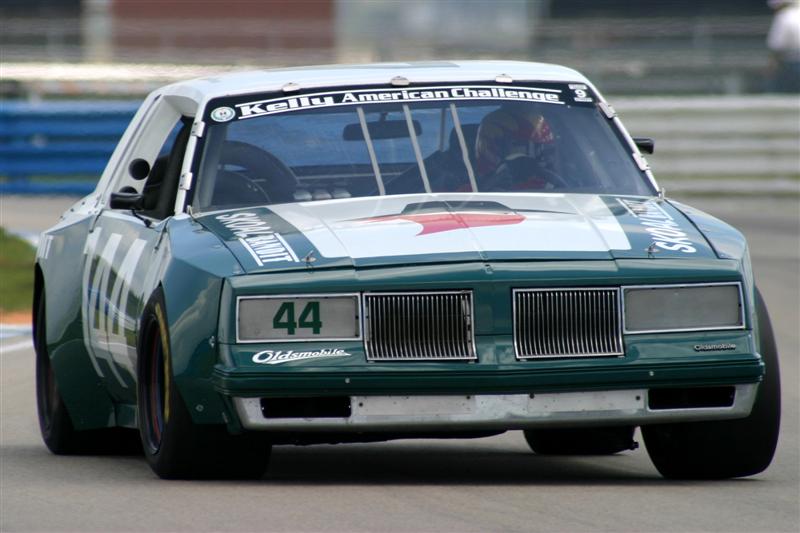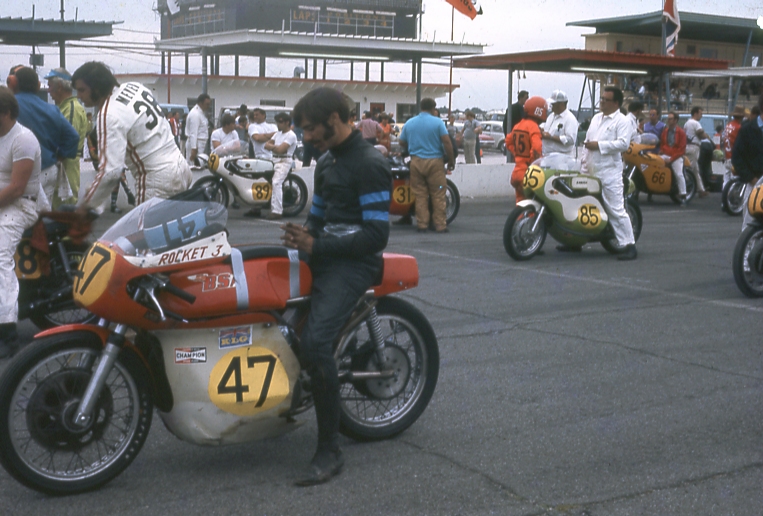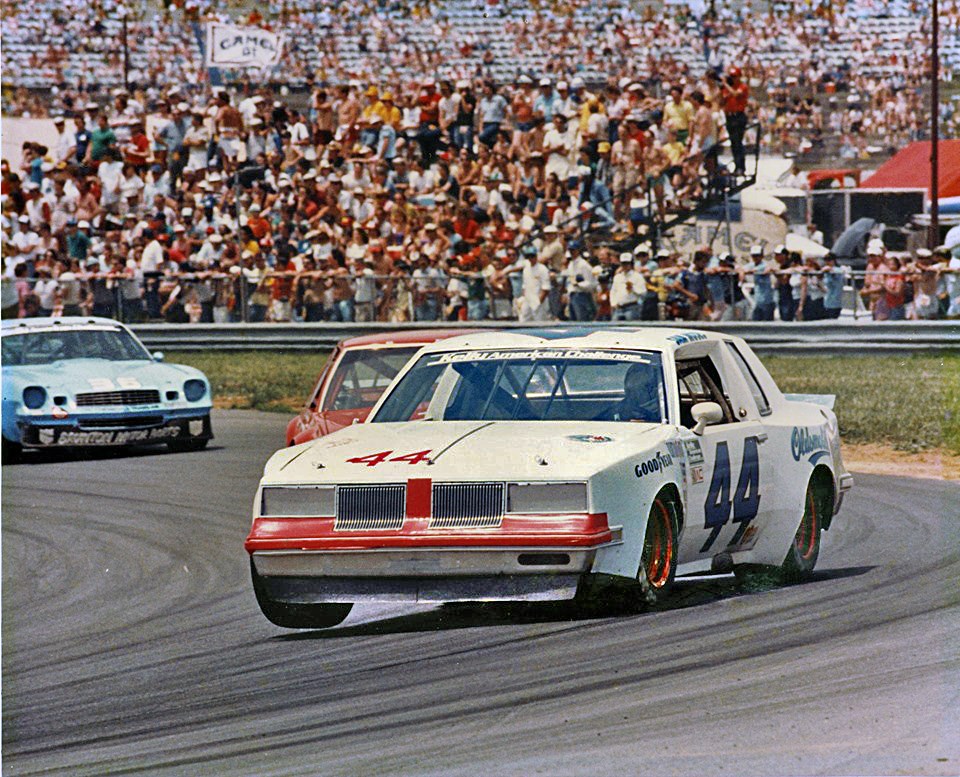![]() Sportster street tracker from racer, author, and moto-journalist Sam Moses…
Sportster street tracker from racer, author, and moto-journalist Sam Moses…
Today we’re thrilled to feature an ’01 Harley-Davidson Sportster street tracker from one of our most interesting and esteemed readers, Samuel Moses. Sam has quite the history with both cars and bikes. His father was an SCCA national sports car champion who raced a Berkeley powered by a 500cc Excelsior 2-stroke triple motorcycle engine, and Sam made his own road racing debut at 17 years old, racing a Yamaha YDS2 at Watkins Glen.

After a stint in the Navy during Vietnam, Sam began motorsports journalism career, serving as an editor at such publications as MotorCycle Weekly and Cycle Guide. He broke his way into Sports Illustrated with a story on none other than King Kenny Roberts. He’d remain at Sports Illustrated as a motorsports staff writer for 18 years before going to AutoWeek.

Sam raced both cars and motorcycles along the way, securing an FIM 24-hour world record at Daytona with a Kawasaki factory team of five riders, racing AHRMA BOT (Battle of the Twins) on a Ducati 750, and he even built a Kawasaki ZXR1400 landspeed racer that set a Lake Gairdner record of 190 mph naked, which still stands. His final road race was the Daytona Masters pro-am on a factory-supported GS750, where he finished 10th overall and 3rd amateur at age 50…starting from the last row!
He also raced one badass Oldsmobile stock car, “The Bandit,” and wrote a book about the experience: Fast Guys, Rich Guys, and Idiots.
“Sam Moses, a motorsports writer for Sports Illustrated, was assigned to go racing and write about what happened. Fast Guys, Rich Guys, and Idiots is a personal odyssey that peers over the cliff of change and into the pit of obsession. From small-time races to glittery grands prix, it lays bare the greed, lust, and desperation of every driver for time behind the wheel and a faster car. It explains the perfectionism behind taking a turn at the limit and describes the intoxicating thrill of stealing down the Daytona backstraight at nearly two hundred miles an hour.”

Later, he built bikes out of The Bandit’s travel trailer under the name Samoto. Today Sam lives on the small Indonesian island of Lombok:
“At age 77 I get my thrills blasting on a Kawasaki 250 Supermoto with Norifumi exhaust over winding ripply roads with little traffic but many hazards from buffalo shit on blind corners to 8-year-olds riding two-up and weaving unpredictably on electric scooters.”
Legend! The bike you see here is an ’01 Harley Sportster, which Sam bought as an insurance write-off. His original plan was to build a Baja desert sled, as he’d been wintering in Los Barriles, Mexico — a town 65 miles south of La Paz, the end point of the Baja 1000. The bike already had a 21-inch front wheel with knobby tire, so it was pointed in the right direction.
When Sam quit going to Baja, however, he decided to build the bike as a café racer tribute to one of his racing heroes, the great Lance Weil — one of the first Americans to race in Europe in the 1960s. One of Weil’s best-known bikes was an 833cc Harley XLR-TT he built in the US and brought to the UK to race in unlimited class events.
“The big engine had tremendous torque and could be ridden around the entire Brands Hatch circuit at racing speeds in top gear.” -Weil obituary

Sam dubbed his Sportster “Lance” in honor of the late racing pioneer. However, he soon decided that 70 was a little too old to ride around in a racing tuck, so “Lance” was re-envisioned as an XR750-inspired street tracker.
“My roots ran deep with Harley flat trackers, love for the XR750, sweet memories of the San Jose and Sedalia Mile. Wrote a feature article on Mark Brelsford for MotorCycle Weekly, where I worked at the time, the year he was #1. I still believe, with many others, that the XR750 has the most beautiful lines of any motorcycle ever built. So I finished it as a street tracker.”
The upgrades here are more extensive than most Sportster street trackers we see. Sam was aiming for big torque, agile handling, and not a lick of chrome — just black, billet, and polished alloy. In terms of engine, the bike is running an S&S 1200cc kit with a Mikuni HSR 42mm carb, 2:1 Dyna header, stainless Cone Engineering reverse-cone silencer, and a Baker 5-speed shift drum for super smooth shifting.
The rear wheel is a custom 18-inch three-spoke mag, while the front is a 19-inch OEM Harley unit powder-coated black. Of course the bike was converted to chain drive — de rigueur for a street tracker build. Handling has been tightened up with a Progressive fork kit that includes stiffer springs and slightly lower ride height, along with a powder-coated fork brace and 15-inch Burly Stiletto rear shocks (which are actually made by Progressive). We run these same shocks on a favorite member of our stable — “Blitzen” — and love them.
The bodywork is XR750 replica fare, including a Saddlemen tail section / seat and steel tank with 1930s vintage decal laid under the clearcoat. A big Koso analog tach stares at the rider from between the wide tracker bars, while Storz rearsets mean the riding experience is more racebike than armchair.
Sam also has an uninstalled Phil Little Racing steering head kit, which steepens the rake to 27 degrees — a highly cherished, no longer available kit for Hooligan flat track racers. Sam is also considering adding a Phil Little battery cover to go with the bike. Shaped to compliment the oil tank, he believes this side cover will properly complete the bike.
All in all, this is one of the best Sportster street trackers we’ve seen, even cooler because it’s built by a former racer and journalist from the glory days of racing history. Best of all, “Lance” is currently for sale! Interested parties can email Sam for details. It will also be going up on Bring a Trailer soon. Note: Though Sam now lives in Indonesia, the bike is currently located in the States.
Below is our full interview with Sam, which includes many more details of his story and the bike itself. And credit goes to Sam’s son, Maks (@maksmoses), for the photos. Enjoy!
Builder Interview: Sam Moses

• Please tell us a little about yourself, your history with motorcycles, and your workshop.
Dad in the ’50s raced sports cars, against the likes of Roger Penske; he was SCCA national champion in a Berkeley with a 500cc Excelsior 2-stroke triple motorcycle engine.
First motorcycle at age 17 was a Yamaha YDS2, two months later made roadracing debut AAMRR Watkins Glen. Joined Navy age 19, drove from Pennsylvania to San Diego towing Yamaha DT1 — wish I had it now, a perfect machine. Raced Daytona 1971 on Don Vesco-built Rickman BSA 750 triple, banking trap speed matched factory bikes (though hardly lap times of my hero Mike Hailwood and others).

Two days after discharge in 1971 was at the Isle of Man, beginning of motorcycle journalism career, spent that summer following world championship circuit. Hired by MotorCycle Weekly as feature editor, then Cycle Guide as editor, a golden three years writing about racers and races around the country and world, including Cal Rayborn’s legendary six races on his Harley at the Anglo-American Match Races (most memorable of all racing events I’ve written about, including 18 Indy 500s).

Broke into Sports Illustrated with a story on Kenny Roberts, hired as staff writer for motorsports, gig lasted 18 years. Set FIM 24-hour world record at Daytona on a Kawasaki factory team of five riders. Raced cars, wrote memoir Fast Guys, Rich Guys and Idiots.

As deputy editor at AutoWeek in the late ’90s, returned to roadracing bikes, AHRMA BOT on Ducati 750. Final road race age 50 Daytona Masters pro-am on factory-supported Suzuki GS750, 10th overall, 3rd amateur, starting last row of three waves, magazine story.

In Oregon, built a few bikes as Samoto, shop squeezed neatly into 20-ft enclosed trailer that hauled the Bandit Oldsmobile race car that starred in Fast Guys. Favorites include Honda CBX (I’ve owned three) with Hailwood-replica flat-black 6-into-6 open pipes; original ’93 Ducati Monster track-day bike; Suzuki GT750 water buffalo that was a replica of a project bike I built for Cycle as a freelancer.
Began Bonneville racing, most memorably on The Bastard, a 1000cc 5-valve Yamaha with purpose-built chassis by the late great Jason Omer; bike is now in the LeMay Museum in Tacoma, Washington. In 2017 in Australia, built a Kawasaki ZX-14R landspeed racer from a crashed bike bought at auction and set a Lake Gairdner record of 190 mph naked, which still stands.

Today live on the Indonesian island of Lombok, where at age 77 get my thrills blasting on Kawasaki 250 Supermoto with Norifumi exhaust over winding ripply roads with little traffic but many hazards from buffalo shit on blind corners to 8-year-olds riding two-up and weaving unpredictably on electric scooters.
• What’s the make, model, and year of the bike?
2001 Harley Sportster.
• Why was this bike built?
Bought as a running insurance writeoff on Ebay because it had a 21-inch front wheel with a knobby tire, and the goal was the ultimate Baja Desert Sled. (At that time I was spending winters in Los Barriles, and ran up and down the untraveled road to the city of San Jose a lot. It was a great idea, fantastic if it had been actually executed.)
But then I stopped going to Baja. So I decided to make it a Lance Weil tribute cafe racer. That legendary 1965 Cycle World article inspired the 17-year-old me more than anything in memory — the month that I read it, I was off to my first road race, AAMRR at Watkins Glen. I got halfway to building the tribute Harley, to the point of naming it “Lance.” It looked very cool with Storz rearsets and clipons. But then I decided I really didn’t want to ride around on the street like that, being 70 or so years old at the time. I would never ride it.

But I did want to blast around short distances, on a bike more nimble if still hardly lightweight. Not only that, my roots ran deep with Harley flat trackers, love for the XR750, sweet memories of the San Jose and Sedalia Mile. Wrote a feature article on Mark Brelsford for MotorCycle Weekly, where I worked at the time, the year he was #1.
I still believe, with many others, that the XR750 has the most beautiful lines of any motorcycle ever built. So I finished it as a street tracker.
• What was the design concept and what influenced the build?
Design concept: The object of the build was monster torque, nimble handling, killer exhaust note, not a glimmer of chrome anywhere, just alloy, billet and black.
• What custom work was done to the bike?
Upgrades include:
- S&S 1200cc kit with cylinders and pistons
- Mikuni HSR 42mm carburetor
- Chain drive conversion with 530 chain and alloy rear sprocket
- Baker Drivetrain 5-speed shift drum
- Storz alloy rearsets with Speed Merchant billet pegs
- 2:1 Dyna header with stainless Cone Engineering reverse-cone megaphone
- Machined aluminum rear hub with 18-inch custom 3-spoke wheel
- Powdercoated front 19-inch OEM Harley wheel (I think from ’70s Sportster)
- Powdercoated fork brace
- Progressive fork kit with stiffer springs, lowered a bit
- 15-inch Burly Stilletto shocks (made by Progressive)
- Bridgestone Battleaxe tires 150/70/18 rear, 110/80/19 front
- XR750 replica steel tank with 1930s vintage Harley decal under clearcoat
- XR750 replica fiberglass Saddlemen seat with black grain upholstery
- Pringle petcock
- Billet aluminum oil drain kit
- Dual-fire ignition coil
- French yellow beam headlamp and small slit-eye amber turn signals
- Billet alloy license plate bracket with slim taillight (not mounted, saved for next owner)
- Koso analog 8000 rpm tachometer
There is a Phil Little steering head kit that steepens the rake, never installed, still in the box. He used to make and sell them to Hooligan racers but no longer. They are considered da bomb and now extremely rare.
• Does the bike have a nickname?
“Lance.”
• Can you tell us what it’s like to ride the finished bike?
I wish. I’ve only ridden it about 50 miles. It doesn’t wobble. It sounds great. The gearbox is tight. I never found any reason why it would have been considered a write-off by an insurance company.
• Was there anything done during this build that you are particularly proud of?
Maybe just the creative and unique mix, reflecting the changes in direction, rather than planned design. The rear shocks are all that’s left of the desert sled. The wide rear wheel, tires, and Storz rearsets are cafe racer. The looks and nimble handling are street tracker.
• Is there anyone you’d like to thank?
Cal Rayborn and every Harley racer from the ’70s.
Photography
The photographer is my son, Maks Moses.
Instagram: @maksmoses
YouTube: www.youtube.com/results?search_query=sickos












“Lance” is great. I’d love it as a daily rider, the way the Sportster motor delivers power is just so satisfying and visceral. But I’d really like to see more of that stealth black Honda CBX, and hear the howl of the six-into-six Hailwood rep pipes.
I am
Not a fan of the CBX. This sportster is wicked cool. And the builder is one storied individual!
Just wondering if Sam wants to sell Lance. 😉 I’m 70 soon 71 and figure it’s a perfect lightweight bike for puttin’ around.